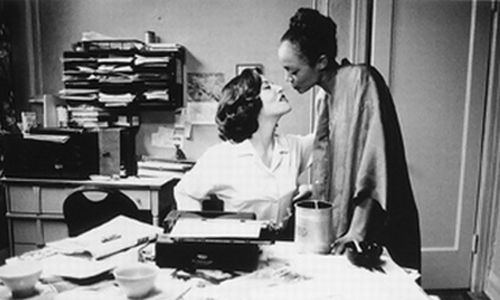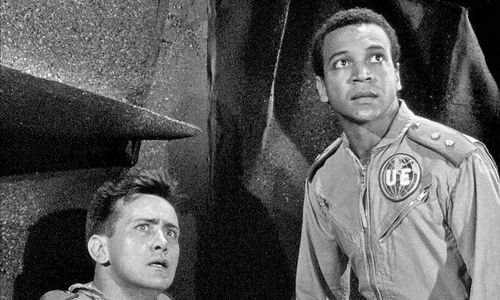
Is He or Isn’t He?: Man Facing Southeast / The Brother From Another Planet
- This is a past program
Presented by the UCLA Film & Television Archive.
Part of the UCLA Film & Television Archive screening series Science Fiction Against the Margins. Learn more at cinema.ucla.edu.
In the stranger-comes-to-town narratives of The Brother From Another Planet and Man Facing Southeast, norms in the human world get shaken up by an alien presence. In both films, the strangers arrive on Earth under mysterious circumstances and, once here, unintentionally adapt to our world via their perceived empathetic gazes on marginalized communities. Their observations of human behavior lead to both comedic events and revelatory critiques of society. Without relying on special effects, these narrative feature films emulate their protagonists and what might or might not be their alien powers in conveying themes of otherness that are relatable even here among earthlings.
Man Facing Southeast (1986)
One day, an odd, lanky young man appears at a state-run psychiatric hospital in Buenos Aires; nobody knows how he got there. The man, who says his name is Rantés, is well spoken but claims to be some sort of extraterrestrial visitor to Earth. Through Rantés’ perspective, bureaucratic jobs and decisions are portrayed as comedic nonsense, and under his influence, fellow hospital inmates rise up against hospital managers in a cacophony of events. But when the film turns away from comedy, the darkness of the psychiatric hospital’s coverups and control is exposed.
Writer-director Eliseo Subiela based his central figure on a man in his neighborhood who for weeks would stand at the corner, staring into a window a few stories up. Subiela’s film combines ideas from his observations with elements from Adolfo Bioy Casares’ 1940 novel The Invention of Morel, which entertains the idea of holograms. After a long search, Subiela found his Rantés when watching a televised play and noticed Hugo Soto’s particular face. Soto went on to perform in several more Argentine films before his untimely death at the age of 41. Man Facing Southeast was one of several allegorical political science fiction films created in post-dictatorship Argentina, released just one year after the Trial of the Juntas found members of the military government responsible for the disappearance and torture of thousands of civilians. Reflecting on a time in which speaking out against the government could get one imprisoned (or worse), Subiela’s film speaks in code about violence, both physical and mental. Could Rantés really be an alien? And if he is telling the truth, what do we make of the people in control who attempt to bury his words?
DCP, color, in Spanish with English subtitles, 105 min. Director/Screenwriter: Eliseo Subiela. With: Lorenzo Quinteros, Hugo Soto, Inés Vernengo.
The Brother From Another Planet (1984)
He arrives at Ellis Island like the immigrants in the late-19th and early-20th century, but our newcomer, played by Joe Morton, is not from another country; he’s from another planet. Even though he is non-human, the appearance of the mute alien’s skin tone identifies him as a Black man on Earth. Our unnamed protagonist, referred to simply as “Brother” by the locals, is being chased through New York City by two space alien bounty hunter types. He passes the time evading his oppressors by observing the class and racial divides on the streets and in bars. “Brother” communicates through his actions: fixing machines with his magical touch and aiding vulnerable community members in Harlem. His acute listening — both to those present and those in the past — allows him to express one of his many alien powers, empathetic listening, a skill that has been long lost among human city folk. Following him around Harlem, silently observing the dynamics of normalized city life, the film at times feels like an alien slacker flick.
Written in about a week, writer-director John Sayles’ fourth feature became his biggest box office hit. Sayles wanted the film to be about the immigrant experience of having to assimilate in a strange land through the parallel of literally being alien to your new surroundings. Even though a low-budget film, The Brother From Another Planet has had a lasting impact on American audiences for both its cinematic qualities and its socio-political message about the immigrant and Black experience in the United States.
35mm, color, 110 min. Director/Screenwriter: John Sayles. With: Joe Morton, Rosanna Carter, Ray Ramirez.
Preserved by the UCLA Film & Television Archive in collaboration with Anarchists' Convention from the original 35mm color negative, a 35mm color reversal intermediate and the original 35mm sound track negative.
The UCLA Film & Television Archive is a division of UCLA Library, and presents its public programs in the Billy Wilder Theater at the Hammer, among other venues. For more information about the Archive, visit cinema.ucla.edu.
ATTENDING THIS PROGRAM?
Ticketing: Admission to Archive screenings at the Hammer is free. Your seat will be assigned to you when you pick up your ticket at the box office. Seats are assigned on a first come, first served basis, limit one per visitor. Box office opens one hour before the event. Questions should be directed to the Archive at programming@cinema.ucla.edu or 310-206-8013.
Member Benefit: Subject to availability, Hammer Members can choose their preferred seats and pick up tickets for one additional guest. Members receive priority ticketing until 15 minutes before the program. Learn more about membership.
Parking: Self-parking is available under the museum. Rates are $8 for the first three hours with museum validation, and $3 for each additional 20 minutes, with a $22 daily maximum. There is an $8 flat rate after 5 p.m. on weekdays, and all day on weekends.
Read our food, bag check, and photo policies.
Read our COVID-19 safety guidelines.













